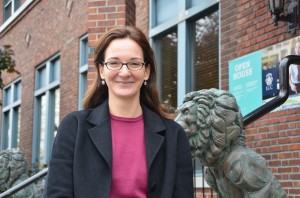 Je suis directrice du programme primaire (de la maternelle à la 6e année) du Lower Canada College et mère de trois enfants âgés de 10, 8 et 3 ans. À titre de professionnelle et de mère, je suis toujours intéressée de savoir où en sont les enseignants dans leur réflexion professionnelle. Lors d’une récente réunion du personnel du programme primaire, j’ai posé la question suivante à mon équipe d’enseignants : « S’il ne vous restait plus qu’une journée à enseigner, quel sujet souhaiteriez-vous aborder avec vos élèves? » Incroyablement, chacun d’entre eux a répondu à la question par des mots comme « respect », « compassion », « tolérance » et « intégrité ». C’était un réel plaisir à entendre!
Je suis directrice du programme primaire (de la maternelle à la 6e année) du Lower Canada College et mère de trois enfants âgés de 10, 8 et 3 ans. À titre de professionnelle et de mère, je suis toujours intéressée de savoir où en sont les enseignants dans leur réflexion professionnelle. Lors d’une récente réunion du personnel du programme primaire, j’ai posé la question suivante à mon équipe d’enseignants : « S’il ne vous restait plus qu’une journée à enseigner, quel sujet souhaiteriez-vous aborder avec vos élèves? » Incroyablement, chacun d’entre eux a répondu à la question par des mots comme « respect », « compassion », « tolérance » et « intégrité ». C’était un réel plaisir à entendre!
Même si on s’attend de nos enseignants qu’ils développent continuellement les divers cours prescrits par le ministère de l’Éducation et qu’ils remplissent des bulletins de notes principalement axés sur la maîtrise des connaissances à l’égard de sujets précis, les écoles jouent également un rôle important dans l’enseignement des aptitudes sociales. En fait, ce rôle constitue même une obligation morale.
Les règles et attentes sociales à l’égard du comportement doivent faire partie du « programme indirect » de toutes les écoles et être enseignées au même titre que d’autres compétences. À moins que nous n’inculquions ces valeurs aux élèves – nos enfants – tout comme nous leur enseignons les mathématiques et la grammaire, nous ne pouvons pas nous attendre à ce que nos jeunes sachent se comporter dans les situations de la vie quotidienne, ni même qu’ils y soient préparés. En fait, comment pourrions-nous être déçus de les voir mal se comporter si au départ on ne leur a pas montré à agir autrement?
Un programme bien défini d’éducation lié au caractère contribue à créer un climat scolaire positif. Nos élèves sont nos leaders de demain et nous ne pouvons qu’espérer qu’au moment de leur remise de diplômes, ils fassent preuve non seulement de capacité intellectuelle, mais aussi de responsabilité sociale.
En mettant l’accent sur l’éducation à la fois de l’esprit et du cœur, nous veillons à ce que nos enfants soient prêts à faire face aux défis que l’avenir leur réserve avec confiance aussi bien qu’avec compassion.
Évidemment, en matière d’éducation du caractère, le soutien de la famille est essentiel, mais je me réserve le sujet du partenariat parent-école pour un futur blogue!
Yasmine Ghandour
Directrice du programme primaire du Lower Canada College et mère de trois enfants




